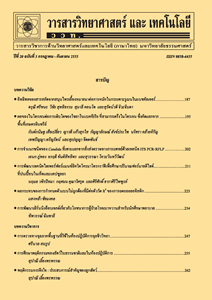Effect of Growing Season and Fertilizer Application Rate on Yield of Rice cv. RD41 under Bang Nam Priao Soil Series
Main Article Content
Abstract
The objective of this study was to determine the time and the optimal amount of fertilizer rate on growth and yield components of early variety rice cv. RD41 under Bang Nam Priao soil series. The experiment was done at Chachoengsao Rice Research Center during rice planting time dry season (2016) and wet season (2017). The experimental design was split-plot in a randomized complete block that included two main plots (dry and wet seasons). The sub-plot was fertilizer rate seven treatments with three replications. The result found that time, fertilizer rate, and interaction between them significantly affected plant height during the age of 15-45 days after planting (p < 0.05). The rice grew in the wet season showed higher attitude than the dry season, about 61 %. Amount of nitrogen at the rate of 24-6-6 in wet season significantly increased plant height but decreased tillering. However, applying the same rate of fertilizer in the drying season significantly increased the tiller number to 42 % compared to the rate of 6-6-6. Nevertheless, time, fertilizer rate, and their interaction showed no effect on panicle length. Moreover, the result noted that panicle number, filled grain rate, 1,000-seed weight, and grain yield of rice cv. RD41 gained seven different fertilizer rates were not different. But, fertilizer at the rate of 12-6-6 in the wet season tended to increase the highest of rice grain yield (655 Kg/rai). Then, the rice farmer should consider the optimal fertilizer rates according to the conditions and environment in their area for achieving sustainable rice production.
Article Details
References
Tabrab, S., 2017, Early Rice Varieties and Good Quality Seed, pp. 73-76, Seminar Paper of Summarizing the Performance and Utilization of the 2017 Research, Research Report, Bureau of Rice Research and Development, Rice Department, Bangkok. (in Thai)
Chuvisitkul, E., 2001, Technology for Producing High Quality Rice, Rice Research Institute, Department of Agriculture, Bangkok, 137 p. (in Thai)
Seeloy-ounkaew, T. and Buddhaboon, C., 2018, Land use and diversity of planting rice varieties in Chachoengsao province, J. Agric. Res. Ext. 35(2): 11-23. (in Thai)
Laywisadkul, S. and Yingjajaval, S., 2019, Plant nutrients of rice (Oryza sativa) var. RD41, Pathum Thani 1 and Khao Dawk Mali 105, Agric. Sci. J. 50: 184-196.
Kaeomuangmoon, T., Jintrawet, A. and Katzfey, J., 2019, Estimating seasonal fragrant rice production in Thailand: A review article, Inter. J. Agric. Technol. 15(5): 707-722.
Sawatyotin, S., 2009, Effect of rock phosphate and dolomite on rice yields in Roi-Et soil series, RMUTI J. Sci. Technol. 2(1): 57-67. (in Thai)
Poomipan, P., Latkanathinnawong, V., Pliumchareorn, C., Chomphuphiw, P. and Thepsilvisut, O., 2017, Effect of high quality organic fertilizer on production of Suphan Buri 1 Rice, Thai Sci. Technol. J. 25(2): 248-259. (in Thai)
Suwanarit, A., Kreetapirom, S., Buranakarn, S., Varanyanond, W., Tungtrakul, P., Som boonpong, S., Rattapat, S., Ratanasupa, S., Romyen, P., Wattanapryapkul, S., Naklang, K., Rotjanakusol, S. and Pornurisnit, P., 1996, Effects of nitrogen fertilizer on grain qualities of Khaw Daok Mali-105 aromatic rice, Kasetsart J. (Nat. Sci.) 30(4): 458-474. (in Thai)
Kheoruenromne, I. 2004. Soil survey operation manual. Kasetsart University Press, Bangkok. 182p.
Seeloy-ounkaew, T. and Kimisae, A., 2018, Soil properties and assessment of soil fertilities in breeder seed and foundation seed of rice seed planting areas, Chachoengsao Rice Research Center, Bangnum-brieo district, Chachoengsao province, KMUTT Res. Develop. J. 41(1): 17-26. (in Thai)
Osada, A., Saciplapa, V., Rahong, M., Dhammanuvong, S. and Chakrabandho, H., 1973, Abnormal occurrence of empty grains of indica rice plants in the dry, hot season in Thailand. Proc. Crop Sci. Soc. Jap. 42: 103-109.
Thai Meteorological Department, 2016, Annual Report 2016, Academic Documents, Ministry of Digital Economy and Society, Bangkok, 119 p.
Zhang, Y., Yu, C., Lin, J., Liu, J., Liu, B., Wang, J., Huang, A., Li, H. and Zhao, T., 2017, OsMPH1 regulates plant height and improves grain yield in rice, PLoS ONE 12(7): 1-18.
Wang, F., Cheng, F.M. and Zhang, G.P., 2007, Difference in grain yield and quality among tillers in rice genotypes differing in tillering capacity, Rice Sci. 14: 135-140.
Wang, Y., Lu, J., Ren, T., Hussain, S., Guo, C., Wang, S., Cong, R. and Li, X., 2017, Effects of nitrogen and tiller type on grain yield and physiological responses in rice, AoB Plants 9(2): 1-17.
Wannasai, C., 2004, Management of Primary Nutrients in Rice Fields, Phitsanulok Rice Research Center, Department of Agriculture, Phitsanulok, 51 p. (in Thai)
Chang, T., 1976, The rice cultures, Philos. Trans. Roy. Soc. Lond. B Biol. Sci. 275: 143-157.
Zhao, B.H., Wang, P., Zhang, H., Zhu, Q. and Yang, J., 2006, Source-sink and grain filling characteristics of two line hybrid rice yangliangyou 6, Rice Sci. 13: 34-42.
Isuwan, A., Khewaram, T. and Promchan, T., 2017, Yield potentials of five varieties of rice grown on Rangsit soil series under site-specific fertilizer management, Song klanakarin J. Plant Sci. 4(2): 46-50. (in Thai)
Li, R., Li M., Ashraf U., Liu, S. and Zhang, J., 2019, Exploring the relationships between yield and yield-related traits for rice varieties released in China from 1978 to 2017, Front. Plant Sci. 10: 1-12.
Sorngmueang, P., 2000, Using Organic Fertilizers in Rice Fields, Bureau of Soil Science, Department of Agriculture, Bangkok, 84 p.
Department of Soil Science, Faculty of Agriculture, Kasetsart University, 2005, Fundamental of Soil Science, Kasetsart University Press, Bangkok, 547 p. (in Thai)
Sealim, S., 2016, Organic Fertilizer and Utilization in Thailand, Soil Biotechnology Division, Land Development Department, Bangkok.
Sorngmueang, P. 2000. Using organic fertilizers in rice fields. Bureau of Soil Science, Department of Agriculture. 84p.
Lecturer of Department of Soil Science. 2005. Fundamental of soil science. Kasetsart University Press, Bangkok. 547p. (in Thai)
Sealim, S. 2016. Organic fertilizer and utilization in Thailand. Soil Biotechnology Division, Land Development Department. 71-103p


